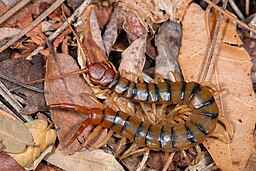Tiger Centipede
Tiger Centipede
 | |
| Domain: | Eukaryota |
|---|---|
| Kingdom: | Animalia |
| Phylum: | Arthropod |
| Class: | Chilopoda |
| Order: | Scolopendromorpha |
| Family: | Scolopendridae |
| Genus: | Scolopendra |
| Species: | S. polymorpha |
Scolopendra polymorpha, commonly known as the Tiger Centipede, it is a species of centipede in the family Scolopendridae. its also known for the distinctive dark bands across its body segments, giving it a tiger-striped appearance.[2]
Description
Scolopendra polymorpha typically grows up to 4–7 inches (10–18 cm) in length. Its coloration varies widely, ranging from light brown to brick red, and sometimes olive, yellow, or bluish hues.[2] A dark band usually runs across each tergite (body segment), inspiring the nickname "Tiger Centipede".[3] The species name, polymorpha, means "many forms" in Latin, reflecting its variable coloration.[4] Tiger centipedes can regenerate lost limbs, making them more resilient against predation. [5]. The hind end forms a "psudeohead" that looks very similar to the head of the centipede, a pair of long legs somewhat Resemble the antenna of the head.[6]
Habitat and Range
This species is distributed across the southwestern United States, from Louisiana to California and Oregon, and south into northern Mexico. S. polymorpha typically inhabits arid environments and tolerates a broad temperature range, from 65–90°F (18–32°C).[4] They are typically found under various sizes of debris, such as boards, logs, and stumps. To prevent drying, desert centipedes hid under rocks during the day and come out at night to hunt.
Diet
S. polymorpha are opportunistic nocturnal predators. It feeds on arthropods, earthworms, and Insects, which it subdues using venom-injecting maxillipeds (modified front legs). Larger individuals may also prey on small reptiles or mammals.[6]
Venom
Tiger Centipedes' venom contains a peptide called SPC13, which exhibits antimicrobial activity against Staphylococcus aureus and Pseudomonas aeruginosa, both major causes of hospital-acquired infections.[7] In mice, the venom has been shown to cause muscle damage, necrosis, and mitochondrial disruption, evidenced by the presence of ragged red fibers.[8] Venom regeneration is limited. After venom extraction, only 65–86% of the venom volume and 29–47% of the protein mass are regenerated within 48 hours. No further regeneration is observed, even after seven months. As the body length of the centipede increases, the rate at which it regenerates venom decreases. Larger centipedes regenerate venom more slowly than smaller ones. making size a limiting factor in its regenerative abilities.[8]
References
- ↑ Hedin, Marshal. “Common Desert Centipede (Scolopendra Polymorpha).” Flickr, Yahoo!, 23 Apr. 2025, https://flickr.com/photos/23660854@N07/50159557983.
- ↑ 2.0 2.1 “Common Desert Centipede (Scolopendra polymorpha).” iNaturalist, https://www.inaturalist.org/taxa/53762-Scolopendra-polymorpha. Accessed 21 Apr. 2025.
- ↑ “Scolopendra polymorpha.” Archive.org, https://web.archive.org/web/20120402114731/http://cacoseraph.exofire.net/centis/S_polymorpha.php. Accessed 21 Apr. 2025.
- ↑ 4.0 4.1 “Godofinsects.com.” Godofinsects.com, https://www.godofinsects.com/index.php/museum/all-non-insects/chilopoda-centipedes/tiger-centipede-scolopendra-polymorpha/. Accessed 21 Apr. 2025.
- ↑ "Scolopendra polymorpha – Tiger Centipede." Picture Insect Wiki, https://pictureinsect.com/wiki/Scolopendra_polymorpha.html. Accessed 21 Apr. 2025.
- ↑ 6.0 6.1 “Desert Centipede (Scolopendra polymorpha).” Colorado State University, https://webdoc.agsci.colostate.edu/bspm/Chilopoda/DesertCentipede.pdf. Accessed 21 Apr. 2025.
- ↑ Rodríguez-Alejandro, C.I., and M.C. Gutiérrez. “Antimicrobial Activity of SPC13, New Antimicrobial Peptide Purified from Scolopendra polymorpha Venom.” *Anti-Infective Agents* 18, no. 3 (2020): 233–38. https://doi.org/10.2174/2211352517666190531110829.
- ↑ 8.0 8.1 Robles, Judith Tabullo De, et al. “Mitochondrial Activity Disruption and Local Muscle Damage Induced in Mice by Scolopendra polymorpha Venom.” *Journal of Venomous Animals and Toxins Including Tropical Diseases* 26 (2020): e20190079. https://doi.org/10.1590/1678-9199-jvatitd-2019-0079.